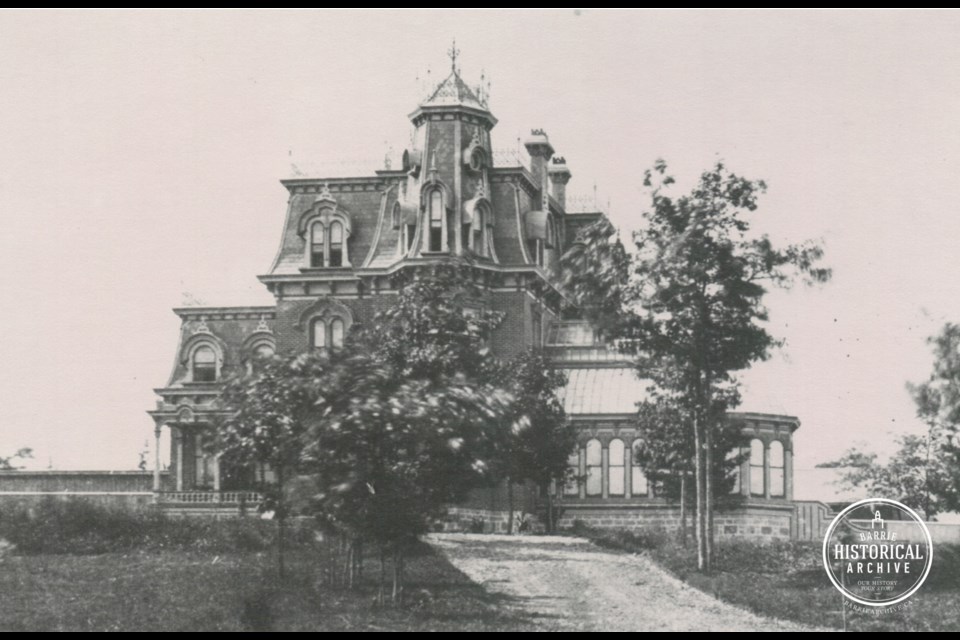This ongoing series from Barrie Historical Archive curator Deb Exel shows old photos from the collection and one from the present day, as well as the story behind them.
The Castle — 25 Valley Dr.
That’s what we called it when we were kids – the Castle.
We didn’t know anything of its history. It was just an eccentric old mansion, perched on a hill in an upscale neighbourhood looking weirdly out of place.
Although Castle Drive was named for this house, and was likely the roadway used to reach the mansion at one time before parcels of land surrounding it were sold off as lots, the current address of this venerable old home is actually Valley Drive, an unnamed road until 1955, later assumed by the City of Barrie in 1976.
Although the formal name of the estate was The Oaks, the grand old home was generally referred to as Lount’s Castle, having been built for Judge William Lount in the late 1870s.
William Lount was born in Holland Landing in 1840, and came to Barrie when his father, George, the Registrar of Lands for Simcoe County, had to relocate for his job. It was George who imported the black walnut trees from his native home in Pennsylvania that were planted at his daughter’s (William’s sister Hannah) home Rockforest II.
William was born two years after his uncle Samuel Lount was hanged in Toronto — exactly 183 years ago this month on April 12, 1838 — for his treasonous role in the 1837 Rebellion in Upper Canada.
William attended the Barrie Grammar School, going on to study law in Toronto, working in the offices of Sir Adam Wilson, then Sir Oliver Mowat, before passing the bar and returning to Barrie to open a practice in 1863.
Lount served as MPP for Simcoe North from 1867 to 1871. He was defeated when he ran again in the next general election, but continued to remain active in parliamentary elections as president of the North Simcoe Reform Association. He was made Queen’s Council in 1876 by the Ontario Government and the Dominion Government conferred the same honour on him in 1881. Lount was president of the Ontario Cricket Association for some time and an avid player himself.
In 1874, William married Jane Willimina Orris of Dunnville, Ont. In 1877, they built their majestic castle, inviting the press the following spring for a tour shortly before it was completed in 1878. The overall design was considered Second Empire and the contractor/builder was George Ball, who had other similar projects of this style, such as the Market Building and the Robinson-Burton house.
To say the home was elegant doesn’t begin to do justice to the impressive home. An imposing house from the road, it only continued to overwhelm its visitors with its over-the-top opulence as they entered through the enormous and beautifully carved oak doors that were set with delicate cut glass lights.
To left of the entrance hall was a large drawing room with a fireplace. To the right, was the reception room, also spacious and with an attractive fireplace, the dining room off the reception room and kitchen was beyond that.
Up the handsome staircase, past the only stained-glass window in the home, were the bedrooms, each painted a different colour, which was considered quite bold and unusual at the time.
Other upstairs rooms included the bathroom, smoking room, billiard room, clothes rooms and the servants’ rooms.
There was reportedly a ballroom on the third floor, although that was not mentioned in the description of that time.
The home was filled with the finest of furnishings and lavishly finished with extravagant decorative moldings, beautiful woodwork and included all manner of conveniences. It was heated throughout with steam, had machinery to deliver water within the house and a bell system in all the main rooms to connect to the servants’ department.
As an aside, a month after this behind-the-scenes tour, artesian well sinkers had to abandon a job at Lount’s when, at 360 feet, the pipe became crooked. We assume the situation was later resolved.
Attached to the house was a magnificent conservatory, heated by hot water pipes. With a price tag of $10,000, it’s no wonder it was considered a castle and likely the most prestigious residence in town (or on the outskirts of town as it were!).
After practising law in Barrie for 22 years, in 1885, Lount moved to Toronto, with The Oaks becoming a summer residence. His wife, Jane, died in 1891 and William was remarried in 1893 to Isabella Hornibrook.
Lount had gained quite the reputation as a criminal lawyer and in 1895, won probably his most well-known case: the Hyams trial.
Twin brothers Harry Place and Dallas Theodore Hyams, formerly of New Orleans, living in Toronto as of about 1890 and working on King Street, were accused of murdering 16-year-old Willie Wells. It was never very clear what brought the twins to Toronto, since they had no real connections there and had wealthy relatives back in Louisiana.
They didn’t seem to do much commission trading in their King Street warehouse, either, although they seemed to have resources to live on… until they didn’t and were constantly borrowing money and in debt.
The previous winter, or about 1891-92, the twins met Willie and his brother-in-law Aylesworth in Oshawa, offering them employment in their warehouse for a loan of $1,000 each. Willie, his three sisters, Aylesworth and his wife came to Toronto.
To make a long, complicated story short, Harry became engaged to one of Willie’s sisters. He also convinced Willie to take out a $30,000 insurance policy, naming his sister as beneficiary. The twins also tried to persuade Aylesworth to take out a policy, but he was less impressed with the Hyams than Willie. After about a year, he managed to get his $1,000 loan repaid and stopped working regularly for the brothers.
As it turns out, Willie wasn’t that happy with his employment, either, and was planning to use his own $1,000, due to be returned Jan. 14, 1893, to buy a farm near Pickering from an uncle. But he never showed up in Whitby that day to meet his kin to complete the transaction.
Two days later, he was found in the elevator shaft of the warehouse with a 200-pound elevator weight on his head. The only people in the building at the time were Harry and Dallas.
The death was deemed an accident. Willie was taken home to be buried and four months later. Harry married Willie’s sister and the twins’ financial worries seemed to have disappeared.
As it turns out, Harry had extracted $9,000 of insurance money from Willie’s sister, his intended, before their wedding. He also paid Aylesworth, who opposed the marriage, $5,000, "just to keep peace" in the family.
By 1894, Harry was now actively pursuing a $250,000 insurance policy on his wife, while also persuading her try a new folding bed which snapped up against the wall. This, along with her (and others) growing suspicions about the circumstances surrounding her brother Willie’s death, prompted Mrs. Hyams to seek a lawyer for a separation allowance.
The lawyer threatened Harry with publicity if he didn’t pay the allowance. Without actually revealing anything, the lawyer had also hinted to a reporter what was going on. The reporter commenced digging into the story, following up on the misgivings of family, the insurance company and others regarding Willie’s accidental death.
As a result, almost two years to the date of his demise, on Jan. 12, 1895, Harry and Dallas Hyams were charged with the murder of William Chinook Wells, and confined to the Toronto jail.
The twins’ rich relatives in New Orleans, hoping to avoid the hanging of the boys, engaged Francis Wellman, the most prominent criminal attorney in New York, to represent the brothers. Although, due to process, Canadian lawyers conducted the actual defence, with William Lount defending Harry and E.F.B. Johnstone K.C. for Dallas. B.B. Osler was the prosecution.
A spectacular trial ensued, with many witness for both sides and wildly dramatic and conflicting medical opinions on the injuries of the deceased. Finally, Lount and Johnstone delivered powerful and compelling statements to the jury while the Crown attacked Mrs. Hyams for testifying against her husband (the same one who was likely plotting to ‘collect’ some insurance money on her!).
In the end, on May 24, 1895, two jurors voted to convict and 10 to acquit. The judge discharged the jury and scheduled a new trial, which took place in November that year.
At the second trial, new evidence was presented in favour of the defendants, the new judge advised the jury “It is better that very many persons who are guilty escape than that one innocent person should suffer” and apparently Wellman arranged for the notorious ‘fixer’, Col. Foster to be in Toronto… once the jury was announced.
The jurors subsequently had many visitors to their homes (salesmen, agents, photographers and other random strangers) making arguments for the defence. The second trial ended in a complete acquittal.
Lount was involved in other prominent murder cases throughout his career, but had also been a Crown prosecutor on many important cases. He was known to be quite eloquent in the courtroom and fought hard for his clients, at the same time was considered sweet, amicable, a good friend and without any enemies.
At the Dominion general elections in 1896, he was elected to represent Centre Toronto for the Liberals, however resigned the seat in 1897.
In 1901, Lount was appointed to the Common Pleas Division of the High Court.
So it was a shock to all, when William Lount passed away in 1903 at only 63 years old. The judge had been diagnosed with Bright’s disease the previous spring and took a leave to go abroad for his health.
After the summer session, Lount spent the winter in Bermuda where he broke his leg, returning to Toronto in March before succumbing to his illness in April.
A funeral was held at his home in Toronto, then Judge Lount made his last trip to Barrie.
Before the train carrying the remains of Judge Lount arrived in Barrie, public buildings and places of business were closed. Large crowds were at the station to meet the train and show their respect to the distinguished former member of their town and county.
The casket was opened before it was placed in the hearse so people could look one last time at the revered Judge Lount. Judge Boys, Police Magistrate Ross, H.H. Strathy, Dr. Morton, A.E.H. Creswicke and R.L. Barwick carried William Lount to his grave at Barrie Union Cemetery.
Today, Lount’s Castle, once home to a privileged family and then apartments for regular people, has 10 executive furnished apartments and has been restored to its stunning glory. It stands as a remarkable and significant heritage building, preserving an important piece of our community’s history.


